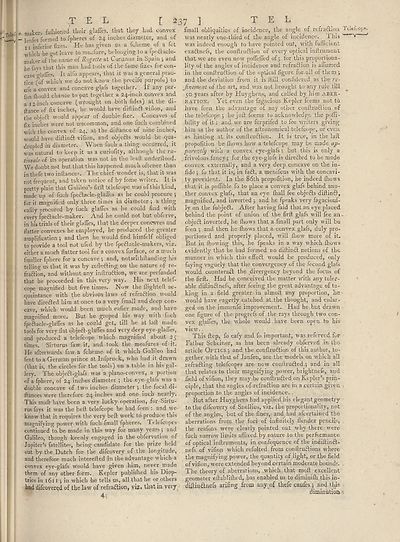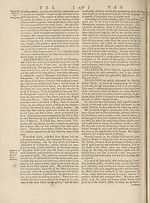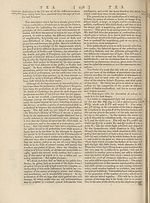Encyclopaedia Britannica, or, a Dictionary of arts, sciences, and miscellaneous literature : enlarged and improved. Illustrated with nearly six hundred engravings > Volume 20, SUI-ZYM
(271) Page 237
Download files
Complete book:
Individual page:
Thumbnail gallery: Grid view | List view

TEL [ 237 ] TEL
1 f, e lakers falhioned their glafies, that they had convex fmall obliquities of incidence, the angle of refraclion 1
,1 f()rme(l t0 fpljfres of 24 inches diameter, and of was nearly one-third of the angle of incidence, ihis
• , f inferior fixes. He has given us a fcheme of a fet was indeed enough to have pointed out, with fuflicient
wb’ch he got leave to meafure, belonging to a fpedtacle- exadlnefs, the conftrudion of every optical inftrument
maker of the name of Rogette at Corunna in Spain •, and that we are even now poffeffed of; for this proportiona¬
te pavs that this man had tools of the lame fixes for eon- lity of the angles of incidence and refraction is ailumed
cave Vlafles. It alfo appears, that it was a general prac- in the confiruction of the optical figure for all of them.;
lice (of which we do not know the precife purpofa) to and the deviation from it is Itill confidered as the re-
ufe a convex and concave glafs together. If any per- Jinement of the art, and was not brought to any rule till
fon (hould chance to put together a 24-inch convex and 50 years after by Huyghens, and called by him aber-
a 12 inch concave (wrought on both fides) at the di- RATION. Yet even the fagaeious Kepler teems not to
fiance of fix inches, he would have ditlinff vifion, and have feen the advantage of any other conftruflion of
the objeft would appear of double fixe. Concaves of the telefcope ; he juft teems to acknowledge the po$i-
fix inches were not uncommon, and one fueh combined bility of it : and we are furprifed to fee writers giving
with the convex of 24, at the diftanee of nine inches, him as the author of the aftronomical telefeope, or even
would have diftinft vifion, and objects would be qua- as hinting at its conftruftion. It is true, in the laft
drupled in diameter. When fuel) a thing occurred, it propofition he (hows how a telefcope may be made ap-
was natural to keep it as a euriofity, although then?- parently with a convex eye-glafs: but this is only a
twnale of its operation was not in the leaft underftood. frivolous fancy; for the eye-glafs is directed to be made
We doubt not but that this happened much oftener than convex externally, and a very deep concave on the in-
in thefe two inftances. The chief wonder is, that it was fide ; fo that it is, in faft, a menifeus with the concavi-
not frequent, and taken notice of by feme writer. It is ly prevalent. In the 86th propofition, he indeed (hows
pretty plain that Galileo’s fir ft telefeope was of this kind, that it is poffible fo to place a convex glafs behind ano-
made up of fuch fpeflaele-glades as he could procure ; ther convex glafs, that an eye (hall fee objeas diftina,
for it magnified only three times in diameter ; a thing magnified, and inverted ; and he fpeaks very fagaciouf-
eafily procured by fuch glades as he could find with ly on the fubjea. After having faid that an eye placed
every fpeaacle-maker. And he could not but obferve, behind the point of union of the firft glafs will fee an-
in his trials of their glades, that the deeper concaves and objea inverted, he (hows that a fmall part only will be
(latter convexes he employed, he produced the greater feen ; and then he (hows that a convex glafs, duly pro-
amplification ; and then he would find lumfelf obliged portioned and properly placed, will (how more of it.
to provide a tool not uftd by the fpedlacle-makers, viz. But in (bowing this, he fpeaks in a way which (hows
either a much flatter tool for a convex furfaee, or a much evidently that he had formed no diftinft notions of the
fraaller fphere for a concave; and, notvvithftanding hjs manner in which this effeft would be produced, only
telling us that it was by i;eflefting on the nature of re- faying vaguely that the convergency of the fecond glafs
fraftion, and without any infiruaion, we are perfuaded would counteraft the divergency beyond the focus of
that he’ proceeded in this very way. His next telef- the firft. Had he conceived the matter with any toler-
cope magnified but five times' Now the (lighted ae- able diftinanefs, after feeing the great advantage of ta-
quaintance with the obvious laws of refraaion would king in a field greater in almoft any proportion, he
have direaed him at once to a very fmall and deep con- would have eagerly catehed at the thought, and enlar-
cave, which would been much eafier made, and have ged on the immenfe improvement. Had he but drawn
magnified more. But he groped his way with fueh one figure of the progrefs of the rays through two con-
fpeftacle-glaffes as he could get, till he at laft made vex glades, the whole would have been open to his
tools for very flat bbjetf-glades and very deep eye-glades,, view.- r j r
and produced a telefcope which magnified about 25 This ftep, fo eafy and fo important was relerved for
times, Sirturus faw it, and took, the mesfures of it. Father Schemer, as has been already obdrved m-tLc
He afterwards faw a fcheme of it which Galileo had article Optics; and the conftruaion of this, author, to-
fent to a German prince at Infpruck, who had it drawn g,ether with that of Janfen, are the models on .vhith au
(that is, the circles for the tools) on a table in his gal- refra&ing telefcopes are now conftruaed.; and in all
lery. The obje-a-glafs was a plano-convex, a portion that relates to their magnifying power, brightnefc, and
of a fphere, of 24 inches diameter ; the eye-glafs was a field of vifion, they may be conftmaed on Kepler’s prm-
double concave of two inches diameter ; the focal di- ciple, that the angles of refraaion are in a certain given
ftances were therefore 24 inches and one inch nearly. proportion to the angles of incidence. .
This muft have been a very lucky operation, for-Sirtu- But after Huyghens had applied his elegant geometry
rus favs it was the beft telefcope he had feen : and we to the difeovery of Snelhus, vix. the. proportionality, not
know that it requires the very beft work to produce this of the angles, but of the fines, and had afeertained the
magnifying power with fuch fmall fpheres. Telescopes aberrations from the foci of infinitely (lender pencils,
continued tube made in this way for many years; and the reafons were clearly pointed out why there were
Galileo, though keenly engaged in the obfervation of fuch narrow limits affixed.by nature to the performance
Jupiter’s fatellites being candidate for the prize held of optical inftruments, in confequence of the indiftindl:-
out by the Dutch for the difeovery of the longitude, nefs of vifion which refulted. from confiruiftions where
and therefore much interefted in the advantage which a the magnifying power, the quantity of light, or the field
convex eye-glafs would have given him, never made ofvifion, were extended beyond certain moderate bounds. .
them of any other form. Kepler publiffied his Diop- The theory of aberrations, .which that moft excellent
tries in 1611 ; in which he tells us, all that he or others geometer eftabliffied has enabled us to dimimffi this m-
difeovered of the law of refra&ion, vi?. that in very diilindtnefs arifing from any .of thefe caufes; and t his
. ' diminutions.
1 f, e lakers falhioned their glafies, that they had convex fmall obliquities of incidence, the angle of refraclion 1
,1 f()rme(l t0 fpljfres of 24 inches diameter, and of was nearly one-third of the angle of incidence, ihis
• , f inferior fixes. He has given us a fcheme of a fet was indeed enough to have pointed out, with fuflicient
wb’ch he got leave to meafure, belonging to a fpedtacle- exadlnefs, the conftrudion of every optical inftrument
maker of the name of Rogette at Corunna in Spain •, and that we are even now poffeffed of; for this proportiona¬
te pavs that this man had tools of the lame fixes for eon- lity of the angles of incidence and refraction is ailumed
cave Vlafles. It alfo appears, that it was a general prac- in the confiruction of the optical figure for all of them.;
lice (of which we do not know the precife purpofa) to and the deviation from it is Itill confidered as the re-
ufe a convex and concave glafs together. If any per- Jinement of the art, and was not brought to any rule till
fon (hould chance to put together a 24-inch convex and 50 years after by Huyghens, and called by him aber-
a 12 inch concave (wrought on both fides) at the di- RATION. Yet even the fagaeious Kepler teems not to
fiance of fix inches, he would have ditlinff vifion, and have feen the advantage of any other conftruflion of
the objeft would appear of double fixe. Concaves of the telefcope ; he juft teems to acknowledge the po$i-
fix inches were not uncommon, and one fueh combined bility of it : and we are furprifed to fee writers giving
with the convex of 24, at the diftanee of nine inches, him as the author of the aftronomical telefeope, or even
would have diftinft vifion, and objects would be qua- as hinting at its conftruftion. It is true, in the laft
drupled in diameter. When fuel) a thing occurred, it propofition he (hows how a telefcope may be made ap-
was natural to keep it as a euriofity, although then?- parently with a convex eye-glafs: but this is only a
twnale of its operation was not in the leaft underftood. frivolous fancy; for the eye-glafs is directed to be made
We doubt not but that this happened much oftener than convex externally, and a very deep concave on the in-
in thefe two inftances. The chief wonder is, that it was fide ; fo that it is, in faft, a menifeus with the concavi-
not frequent, and taken notice of by feme writer. It is ly prevalent. In the 86th propofition, he indeed (hows
pretty plain that Galileo’s fir ft telefeope was of this kind, that it is poffible fo to place a convex glafs behind ano-
made up of fuch fpeflaele-glades as he could procure ; ther convex glafs, that an eye (hall fee objeas diftina,
for it magnified only three times in diameter ; a thing magnified, and inverted ; and he fpeaks very fagaciouf-
eafily procured by fuch glades as he could find with ly on the fubjea. After having faid that an eye placed
every fpeaacle-maker. And he could not but obferve, behind the point of union of the firft glafs will fee an-
in his trials of their glades, that the deeper concaves and objea inverted, he (hows that a fmall part only will be
(latter convexes he employed, he produced the greater feen ; and then he (hows that a convex glafs, duly pro-
amplification ; and then he would find lumfelf obliged portioned and properly placed, will (how more of it.
to provide a tool not uftd by the fpedlacle-makers, viz. But in (bowing this, he fpeaks in a way which (hows
either a much flatter tool for a convex furfaee, or a much evidently that he had formed no diftinft notions of the
fraaller fphere for a concave; and, notvvithftanding hjs manner in which this effeft would be produced, only
telling us that it was by i;eflefting on the nature of re- faying vaguely that the convergency of the fecond glafs
fraftion, and without any infiruaion, we are perfuaded would counteraft the divergency beyond the focus of
that he’ proceeded in this very way. His next telef- the firft. Had he conceived the matter with any toler-
cope magnified but five times' Now the (lighted ae- able diftinanefs, after feeing the great advantage of ta-
quaintance with the obvious laws of refraaion would king in a field greater in almoft any proportion, he
have direaed him at once to a very fmall and deep con- would have eagerly catehed at the thought, and enlar-
cave, which would been much eafier made, and have ged on the immenfe improvement. Had he but drawn
magnified more. But he groped his way with fueh one figure of the progrefs of the rays through two con-
fpeftacle-glaffes as he could get, till he at laft made vex glades, the whole would have been open to his
tools for very flat bbjetf-glades and very deep eye-glades,, view.- r j r
and produced a telefcope which magnified about 25 This ftep, fo eafy and fo important was relerved for
times, Sirturus faw it, and took, the mesfures of it. Father Schemer, as has been already obdrved m-tLc
He afterwards faw a fcheme of it which Galileo had article Optics; and the conftruaion of this, author, to-
fent to a German prince at Infpruck, who had it drawn g,ether with that of Janfen, are the models on .vhith au
(that is, the circles for the tools) on a table in his gal- refra&ing telefcopes are now conftruaed.; and in all
lery. The obje-a-glafs was a plano-convex, a portion that relates to their magnifying power, brightnefc, and
of a fphere, of 24 inches diameter ; the eye-glafs was a field of vifion, they may be conftmaed on Kepler’s prm-
double concave of two inches diameter ; the focal di- ciple, that the angles of refraaion are in a certain given
ftances were therefore 24 inches and one inch nearly. proportion to the angles of incidence. .
This muft have been a very lucky operation, for-Sirtu- But after Huyghens had applied his elegant geometry
rus favs it was the beft telefcope he had feen : and we to the difeovery of Snelhus, vix. the. proportionality, not
know that it requires the very beft work to produce this of the angles, but of the fines, and had afeertained the
magnifying power with fuch fmall fpheres. Telescopes aberrations from the foci of infinitely (lender pencils,
continued tube made in this way for many years; and the reafons were clearly pointed out why there were
Galileo, though keenly engaged in the obfervation of fuch narrow limits affixed.by nature to the performance
Jupiter’s fatellites being candidate for the prize held of optical inftruments, in confequence of the indiftindl:-
out by the Dutch for the difeovery of the longitude, nefs of vifion which refulted. from confiruiftions where
and therefore much interefted in the advantage which a the magnifying power, the quantity of light, or the field
convex eye-glafs would have given him, never made ofvifion, were extended beyond certain moderate bounds. .
them of any other form. Kepler publiffied his Diop- The theory of aberrations, .which that moft excellent
tries in 1611 ; in which he tells us, all that he or others geometer eftabliffied has enabled us to dimimffi this m-
difeovered of the law of refra&ion, vi?. that in very diilindtnefs arifing from any .of thefe caufes; and t his
. ' diminutions.
Set display mode to:
![]() Universal Viewer |
Universal Viewer | ![]() Mirador |
Large image | Transcription
Mirador |
Large image | Transcription
Images and transcriptions on this page, including medium image downloads, may be used under the Creative Commons Attribution 4.0 International Licence unless otherwise stated. ![]()
| Permanent URL | https://digital.nls.uk/192278070 |
|---|
| Description | Plates 516, 519 and 520 missing. |
|---|---|
| Attribution and copyright: |
|
| Description | Ten editions of 'Encyclopaedia Britannica', issued from 1768-1903, in 231 volumes. Originally issued in 100 weekly parts (3 volumes) between 1768 and 1771 by publishers: Colin Macfarquhar and Andrew Bell (Edinburgh); editor: William Smellie: engraver: Andrew Bell. Expanded editions in the 19th century featured more volumes and contributions from leading experts in their fields. Managed and published in Edinburgh up to the 9th edition (25 volumes, from 1875-1889); the 10th edition (1902-1903) re-issued the 9th edition, with 11 supplementary volumes. |
|---|---|
| Additional NLS resources: |
|

